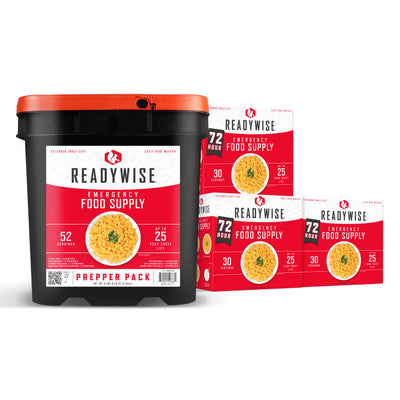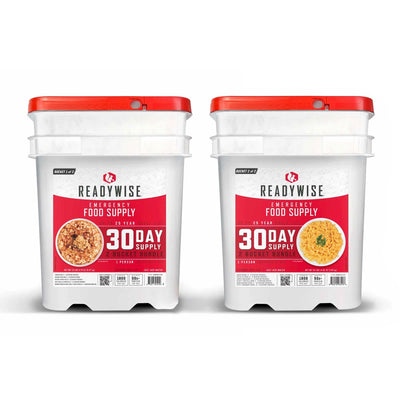Whether you’re planning a camping trip or thinking through your disaster preparedness plan, you might be wondering how to keep food cold without a fridge.
Luckily, you have some options—between insulated containers and ancient solutions (like zeer pots), people have been keeping food cold without refrigeration for generations.
In this guide, we’ll break down everything you need to know to keep your food cold without a fridge.
Utilizing Coolers and Insulated Containers
When thinking about keeping food and emergency supplies cold without refrigeration, coolers may be the first tool to come to mind. And for good reason—coolers are relatively accessible, affordable, and effective for food preservation. However, make sure to:
-
Choose the right cooler – As you explore cooler options, look for high-quality insulation features: polyurethane foams, double-walled insulation, and tight latches.1 At the same time, try to balance capacity with portability; choosing a cooler with wheels could be helpful, depending on your specific use case.
-
Maximize ice retention – If you’re using traditional wet ice, you can employ a few techniques to maximize its lifespan. Using large ice blocks, pre-chilling your cooler before packing it, and keeping drains closed can all help you preserve your ice supply.
Exploring Evaporative Cooling Techniques
What if you don’t have a cooler? Consider an ancient approach: evaporative cooling.
Evaporative cooling requires pot-in-pot insulation, a technique used since as early as 2500 BCE.2 Sometimes called “zeer pots,” these configurations are simple to build. All you need is:
-
A porous clay pot
-
A smaller, non-porous (glazed, for instance) pot that will fit inside the porous pot
-
Sand
-
Water
-
A watering can, measuring cup, or bucket from an emergency food supply kit
-
A cloth big enough to cover both pots
With your materials in hand, you can build your zeer pot with the following process:
-
Place a few inches of sand in the bottom of the large clay pot.
-
Place the smaller, non-porous pot inside of the larger pot (on top of the sand).
-
Fill the remaining space between the two pots with more sand.
-
Place the food you want to cool inside the smaller pot.
-
Using a watering can or a measuring cup, wet the sand between the pots.
-
Wet your cloth and use it to cover your pots.
Why does this work for food cooling? Because as the water evaporates from the sand, it absorbs heat. This gaseous water (and its trapped heat) will move through the porous pot and into the air, keeping the contents of the inner pot cool.
While this won’t keep food ice cold, it can keep foods fresh in hot and dry conditions.
Creating a Root Cellar for Food Storage
If you live in a relatively cool climate, you can leverage the natural cooling properties of soil to build a root cellar: an underground (or semi-underground) storage space that stays cool and humid year-round.3
To build a root cellar, you’ll need to:
-
Choose the right location – While you’ll want to build a root cellar either partially or completely underground, avoid trees: their roots may compromise your cellar’s structural integrity over time.
-
Maintain optimal conditions – Using natural insulation (like leaves and straw), keeping water out during the rainy season, and putting wood shelves inside of your root cellar can help you keep temperatures cool and maintain proper humidity.
Implementing Dry Ice for Cooling
If you have access to dry ice, you can use it for food cooling and refrigeration—with some safety tips in mind:
-
Handle the dry ice safely – To prevent injuries, you’ll need gloves, tongs, and eye protection while you handle dry ice.4
-
Consider evaporation effects – Dry ice is frozen carbon dioxide; while it stays cold for longer than wet ice, it doesn’t produce water when it “melts.” Instead, it evaporates and forms gaseous carbon dioxide, which dissolves into the air.
-
Calculate your dry ice needs – Use tables and calculators available online to determine how much dry ice you’ll need based on your food volume, storage space, and other factors.5
Utilizing Insulated Bags and Packs
Some emergency survival kits leverage the power of insulated packs and bags: containers made from highly insulating materials.
As you search for bags, you’ll likely find options with vinyl or nylon exteriors. While both can effectively insulate, nylon is slightly more breathable.6
However, you’ll need to pack these bags effectively to maintain temperature. One method is to pack items in layers and place cold media (like ice or cold packs) between each layer.
Prepare for Any Emergency with ReadyWise
Most importantly, remember to choose the right technique based on your circumstances. If you need to keep food cold for a road trip, short-term power outage, or camping adventure, coolers with wet ice will meet your needs. If you’re facing a long-term loss of refrigeration, you may need to turn to more primitive solutions, like zeer pots.
Whether you’re passionate about emergency preparedness, stocking up on camping supplies, or simply wanting to reduce your reliance on refrigeration, check out ReadyWise: your partner in emergency prep.
We offer a wide variety of shelf-stable, long-lasting, and highly nutritious meals, snacks, and ingredients—the perfect solutions for frequent campers, emergency preppers, and everyone in between.
Not sure where to start? Explore our best sellers and brainstorm your supply kit now.
Sources:
- Serious Eats. I Tested 11 Coolers to See Which Ones Stayed Ice-Cold and Survived Being Pushed Off of a Truck. https://www.seriouseats.com/best-coolers-8693527
- Scholarly Community Encyclopedia. Pot-in-Pot Refrigerator. https://encyclopedia.pub/entry/28568
- The Old Farmer’s Almanac. Root Cellars: Types and Storage Types. https://www.almanac.com/content/root-cellars-types-and-storage-tips
- University of Washington. Work Safely with Dry Ice. https://www.ehs.washington.edu/system/files/resources/dryice.pdf
- Iceman. Dry Ice Calculator. https://the-iceman.com/dry-ice/dry-ice-calculator/
- Webstaurant Store. How to Keep Food Hot for Deliver with Insulated Bags. https://www.webstaurantstore.com/guide/738/insulated-food-delivery-bags-buying-guide.html?srsltid=AfmBOopiZbyRNNUXEWjLSlWdVblOCjvNj0f7Ep9Z6s4TzlQql6NJiSmM

















































































Storage chocolate sweets 50g box
Storage chocolate price